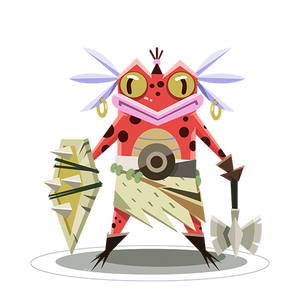About Triggers
By Kitty and Derk · June 2020 · In DepthBack to guides
Unlike other famous card games like Magic: the Gathering, Stormbound does not come with a rulebook explaining in excruciating details how the game mechanics work. We make do with the campaign and some practice battles, but the survive and death trigger resolution can still be a mystery even for experienced players. In this guide, we will attempt to demystify it.
Death Trigger Effects
“Death Trigger Effects” (or DTE for short, symbolised by the little skull icon in the game) are abilities that are resolved when the unit dies.

On death, deal 1 damage to bordering units and poison them

On death, deal 4 damage spread randomly among bordering enemies

On death, spawn a 1 strength Satyr on a random bordering tile

On death, give 3 strength to a random friendly Dragon
Units attacking a base always die right after the damage is done to the base, which triggers their DTE immediately after, unless they destroy the base in which case the game is obviously over.
Resolution order
The rule of thumb goes as follow: when two units with a “Death Trigger Effect” fight and both of them die, the attackedunit will die and resolve its effect first, then the attacking unit will. Same thing goes for STE.
For example if Green Prototypes attack Finite Loopers and both die, the latter will first spawn a construct then the Green Prototypes will boost it, if it spawns on a surrounding tile.
Interesting piece of trivia about the Green Prototypes / Finite Loopers situation: if the looper construct spawns on the tile where Green Prototypes died, it will not gain strength from the Green Prototypes because it is not technically a “surrounding tile”.
Now what if multiple units with a DTE die simultaneously as the result of an area of damage? They will resolve following the same order as the attack pattern of the non-active player (i.e. from right to left then front to back if it is your turn and vice versa, if it’s the enemy turn).
Toxic Sacrifice
Consider the following example in which the player would sacrifice Gifted Recruits with Toxic Sacrifice. The numbers are intended to represent both the order of DTE resolution and the effective strength as well.
The DTE are resolved right-to-left, front-to-back for the active player. That means:
- The damage is applied unilaterally and all units die as a result of the Toxic Sacrifice (level 5) damage.
- Green Prototypes resolve their DTE. Because Spare Dragonling died simultaneously, there is no enemy unit nearby to buff.
- Spare Dragonling resolves its DTE, buffing no dragon.
- Snowmasons resolve their DTE, buffing no nearby unit.
- Finite Loopers resolve their DTE, spawning a construct on a bordering tile.
- Project Ph03-nix resolves its DTE, respawning on the base line.
Crimson Sentry
Consider the following example in which the player would play Crimson Sentry right in the middle. The numbers are intended to represent both the order of DTE resolution and the effective strength as well.
The DTE are resolved right-to-left, front-to-back. That means:
- The damage is applied unilaterally and all units die as a result of Crimson Sentry’s DTE.
- Spare Dragonling resolves its death effect. However, since the damage is applied first, Tegor dies simultaneously and therefore there is no other friendly dragon to buff. The DTE goes to waste.
- Green Prototypes resolve their death effect. Since there are no nearby enemy unit, they do not buff anyone.
- Tegor the Vengeful resolves its death effect. Since the four units die simultaneously, there are no friendly units and no enemy units (since Project PH03-nix did not respawn yet), therefore the trigger is guaranteed to be a dragon spawn.
- Project PH03-nix resolves its death effect, respawning on the base line.
Toxic Sacrifice on Crimson Sentry
Now consider the same example, in which the player would play Toxic Sacrifice (level 5) on Crimson Sentry (level 3). The numbers are intended to represent both the order of DTE resolution and the effective strength as well.
- Crimson Sentry dies as a result of Toxic Sacrifice and resolves its DTE which kills Spare Dragonling, Green Prototypes and Project PH03-nix simultaneously, and puts Tegor down to 1 strength.
- Spare Dragonling (level 1) resolves its DTE and buffs Tegor with 3 strength, making him 4 strength total.
- Green Prototypes (level 2) resolve their DTE and buff Tegor by 2 strength, making him 6 strength total.
- Project PH03-nix resolves its DTE and respawns on the baseline.
- Toxic Sacrifice (level 5) damage is now resolved and bring Tegor down to 1 strength again.
- At the beginning of the player’s next turn, Tegor dies from poison (provided it did not get killed in the mean time).
Toxic Sacrifice on Dubious Hags
Consider the following example, in which the player would play Toxic Sacrifice on Dubious Hags. The numbers are intended to represent both the order of DTE resolution and the effective strength as well.
In this example, because the sacrificed unit resolves its DTE first (as seen earlier with Crimson Sentry), the raven spawn for the enemy is guaranteed to happen on the top bordering tile.
However, this newly spawned unit will not be damaged and killed by Toxic Sacrifice since it spawned after Toxic Sacrifice was played (even though before its damage get resolved).
Survive Trigger Effects
Elder units have effects happening upon surviving damage (“Survive Trigger Effect”, or STE for short).

After surviving damage, drain up to 1 of the damage received from the enemy base

After surviving damage, deal up to 2 of its remaining strength as damage to the first enemy in front

After surviving damage, randomly give strength to 2 other friendly units equal to the damage received

After surviving damage, destroy enemy units in front
For the most part, their resolution pattern is pretty straightforward, but there are things to note:
- Confinement and Siren of the Seas do not cause a STE. Elders can safely be confined without risking triggering their abilities.
- Pre-attack life drain from Witches of the Wild, Amberhides and Feral Shamans’s cause an initial STE (provided the elder survives the drain). Then a second STE might occur if the elder survives the subsequent attack.
- Victors of the Melee, Joust Champions and Overchargers’s abilities cause an initial STE (provided the elder survives it). Then a second STE might occur if the elder survives the subsequent attack.
- Eloth the Ignited, Windmakers, Flaming Stream and Armed Schemers’s abilities cause a STE that is resolved afterthe push/pull.
- Crazy Bombers’s on-play ability causes a single STE per affected elder, and not a STE per bomb. Then a second STE might occur if the elder survives the subsequent attack.
- Booming Professors’s STE causes a STE.
- Broken Earth Drakes and Chaotic Pupil’s DTE cause a STE.
- Forced attacks from Hair-Raising Cats or Laurus, King in Exile cause a STE.
- Poison damage cause a STE. That is what makes Hairy Chestnuts so efficient.
Looking to teach others and guide them towards glorious battles?
Have your own guide published.